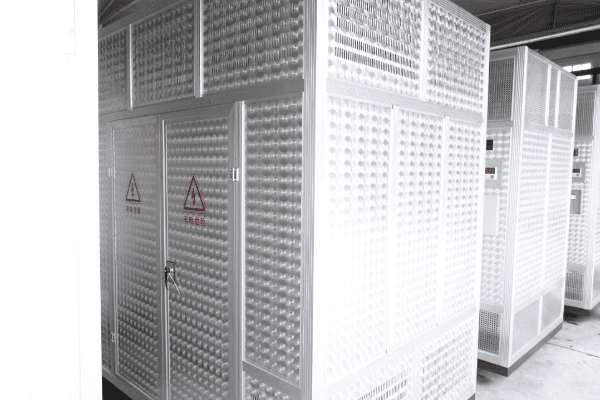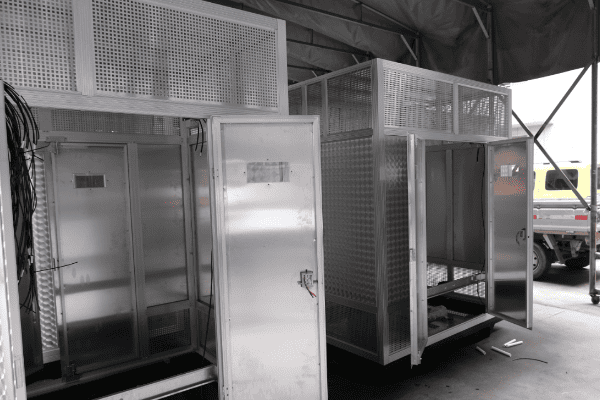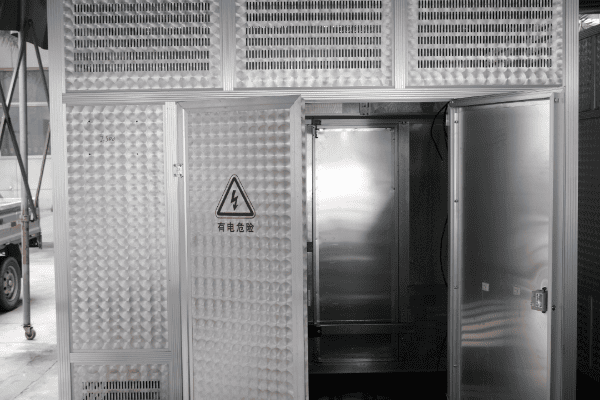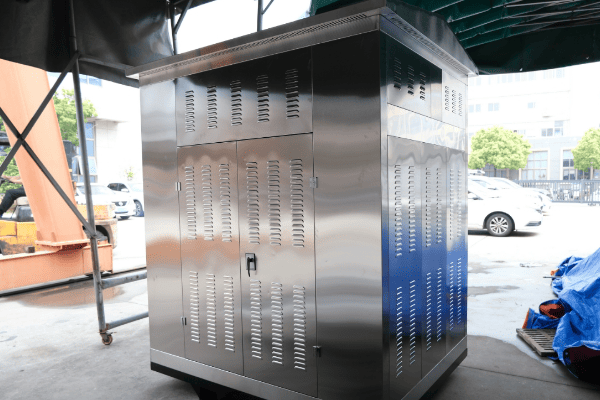What Is The Purpose Of A Power Transformer?
Are you puzzled about the role of power transformers in our electrical systems? You’re not alone. Many people don’t realize how crucial these devices are in keeping our lights on and our devices running.
Power transformers are essential components in electrical systems, enabling efficient transmission and distribution of electrical energy over long distances. They convert high voltage to low voltage, ensuring that electricity can be safely delivered from power plants to homes and businesses.

As someone who has worked with power systems for years, I’ve seen firsthand how vital these transformers are. They’re the unsung heroes of our electrical grid. Let’s dive into the world of power transformers and discover why they’re so important.
What Is a Power Transformer?
Have you ever wondered how electricity from a power plant miles away reaches your home safely? The answer lies in power transformers.
A power transformer is a critical component in electrical power distribution systems, designed to convert high voltage to low voltage for safe and efficient electricity distribution. By altering the voltage levels, power transformers ensure that electrical energy can be transmitted over long distances without significant losses and then distributed safely to homes, businesses, and industries.

I remember the first time I saw a large power transformer up close. It was like looking at the heart of the electrical grid. Let’s break down how these amazing devices work.
How Power Transformers Work
Power transformers operate on a simple yet ingenious principle:
- Core Structure: Made of laminated silicon steel to minimize energy losses.
- Windings: Two main windings – primary and secondary.
- Electromagnetic Induction: The key to voltage transformation.
Here’s a simple equation that governs transformer operation:
[ \frac{V1}{V2} = \frac{N1}{N2} ]
Where:
- V1 and V2 are the primary and secondary voltages
- N1 and N2 are the number of turns in the primary and secondary windings
I once explained this to a group of students using a simple analogy: imagine the transformer as a gear system, where the number of teeth on each gear represents the number of windings. The ratio of these "teeth" determines how the "speed" (voltage) changes.
Applications of Power Transformers
Power transformers are used in various settings:
- Power Generation Plants: Step-up transformers increase voltage for transmission.
- Substations: Step-down transformers reduce voltage for local distribution.
- Industrial Equipment: Ensure machinery receives appropriate voltage.
I once worked on a project to upgrade a substation. The new transformers we installed were able to handle higher loads more efficiently, improving power delivery to an entire neighborhood.
Types of Transformers
Not all transformers are created equal. Each type has its own special role in the electrical system. Let’s explore the main types you’ll encounter.
Transformers come in various types, each designed for specific requirements. The main types include step-up transformers for increasing voltage, step-down transformers for decreasing voltage, and current transformers for measurement and protection.

In my career, I’ve worked with all these types. Each has its own quirks and challenges. Let’s dive into the details.
Step-Up Transformers
These are the powerhouses of the transmission world:
- Purpose: Increase voltage for long-distance transmission
- Location: Typically found at power generation plants
- Example: Boosting 11 kV to 132 kV or higher
I once visited a power plant where the step-up transformers were as big as houses. The hum of electricity was almost palpable.
Step-Down Transformers
These bring power down to our level:
- Purpose: Decrease high transmission voltage to usable levels
- Location: Substations near residential and commercial areas
- Example: Reducing 132 kV to 11 kV or 230 V for household use
The step-down transformer in your neighborhood is what allows you to safely plug in your toaster without it exploding!
Current Transformers
These are the precision instruments of the transformer world:
- Purpose: Measure and monitor current in high-voltage systems
- Operation: Produce a proportional current for measurement devices
- Safety: Allow safe measurement of high currents
I once used a current transformer to diagnose a fault in a large industrial motor. It was like having a microscope for electricity.
Specialized Transformers
There are also more specialized types:
- Pad Mount Transformers: Often used in specific applications like bitcoin mining
- Single Phase vs. Three Phase: Designed for different power distribution systems
Each type of transformer plays a crucial role in our electrical infrastructure. They work together to ensure that power flows smoothly and safely from generation to consumption.
The Importance of Power Transformers in Electricity Distribution Systems
Have you ever thought about how electricity travels from a power plant to your home? It’s a journey made possible by power transformers.
Power transformers are critical for efficient and reliable electricity supply. They enable long-distance transmission by stepping up voltage at generation sites and stepping it down at distribution points. This process minimizes energy losses and ensures stable power delivery to consumers and businesses.

I once worked on a project to upgrade a city’s distribution system. The impact of new, more efficient transformers was remarkable. Let’s explore why these devices are so important.
Key Benefits of Power Transformers
-
Reduced Transmission Losses:
- High-voltage transmission significantly reduces power losses
- More efficient energy transport over long distances
-
Improved Voltage Stability:
- Maintain consistent voltage levels across the grid
- Prevent fluctuations that can damage equipment
-
Enhanced System Resilience:
- Isolate different sections of the grid
- Prevent localized issues from causing widespread outages
I remember a case where a faulty transformer was quickly isolated, preventing a small problem from becoming a citywide blackout. It was a testament to the importance of these devices in maintaining a stable grid.
Power transformers are more than just voltage converters. They’re the guardians of our electrical infrastructure, ensuring that power flows reliably and efficiently to where it’s needed most.
Power Transformers in the National Power Grid
Have you ever wondered how electricity from different power plants all works together in one big system? That’s where power transformers in the National Power Grid come in.
Power transformers play a crucial role in the National Power Grid by handling large-scale electrical power conversion. They ensure electricity can be efficiently and reliably transmitted over long distances, connecting different parts of the grid and maintaining system stability.

I once had the opportunity to visit a major grid control center. The complexity of managing power across an entire country was mind-boggling. Let’s break down the key functions of power transformers in this vast system.
Key Functions of Power Transformers in the Grid
-
Frequency Conversion:
- Allow different parts of the grid to connect smoothly
- Maintain stability and compatibility across regions
-
Voltage Regulation:
- Increase voltage for transmission, decrease for distribution
- Reduce energy losses and improve voltage stability
-
System Resilience:
- Strengthen the grid’s ability to withstand faults
- Help isolate problems and prevent widespread blackouts
I once worked on a project to interconnect two regional grids. The power transformers we used were crucial in harmonizing the different systems, ensuring a seamless flow of electricity across a vast area.
Power transformers are the backbone of our national electrical infrastructure. They handle the complexities of modern grids, ensuring that power flows smoothly and reliably across the entire country.
Innovations in Power Transformer Technology by Meta Power Solutions
Are you curious about the latest advancements in transformer technology? Meta Power Solutions is leading the way with some exciting innovations.
Meta Power Solutions has developed the Ester Oil-Immersed Power Transformer, a sustainable and high-performance solution for large-scale projects. This 750 kV transformer, showcased at CIGRE 2024, offers superior thermal performance, enhanced fire safety, and environmental compatibility, making it ideal for modern energy needs including renewable integration.

I recently had the chance to see this transformer in action, and I was impressed by its capabilities. Let’s explore what makes this technology so special.
Key Features and Benefits
-
Superior Thermal Performance:
- Uses ester oil with a higher flash point
- Operates efficiently under high load conditions
-
Fire Safety Properties:
- Less flammable than conventional insulating oils
- Enhances overall safety profile
-
Environmental Compatibility:
- Biodegradable and non-toxic ester oil
- Minimizes ecological impact
-
Renewable Energy Integration:
- Suited for solar and wind power systems
- Handles fluctuating inputs efficiently
I once worked on integrating a similar transformer into a large solar farm. The improved efficiency and environmental benefits were significant, showcasing the potential of this technology.
Meta Power Solutions is not just improving existing technology; they’re reimagining what’s possible in power transformation. Their innovations are setting new standards for efficiency, safety, and sustainability in the industry.
Conclusion
Power transformers are the unsung heroes of our electrical systems. From enabling long-distance transmission to ensuring safe voltage levels in our homes, they play a crucial role at every stage of electricity distribution. As technology advances, innovations like Meta Power Solutions’ Ester Oil-Immersed Transformer are making these essential devices even more efficient and environmentally friendly. The next time you flip a switch, remember the complex journey that electricity takes to reach you, all made possible by power transformers.
Free CHBEB Transformer Catalog Download
Get the full range of CHBEB transformers in one catalog.
Includes oil-immersed, dry-type, pad-mounted, and custom solutions.
Quick Message
Request A free quote
We'd like to work with you
- +86 15558785111
- [email protected]
- +86 15558785111
What We Do
CHINA BEI ER BIAN (CHBEB) GROUP, with 218 million in registered capital, originated from Beijing Beierbian Transformer Group. Headquartered in Beijing for R&D, it operates major production bases in Nanjing and Yueqing, producing high-quality products.
Latest Product
address
BeiJing
No 3,RongJing East Road,BeiJing Economic Technological Development Area,BeiJing,China
JiangSu
No 7️Xiangfeng Road,Jiangning,NanJing,JiangSu,China
WenZhou
No.211, Wei 16 Road, Industrial Zone, Yueqing, Wenzhou, Zhejiang, China.
XiangYang Industrial Zone ,YueQing,WenZhou,ZheJiang,China
contact us
- [email protected]
- +86 13057780111
- +86 13057780111
- +86 15558785111
Copyright © Bei Er Bian Group


